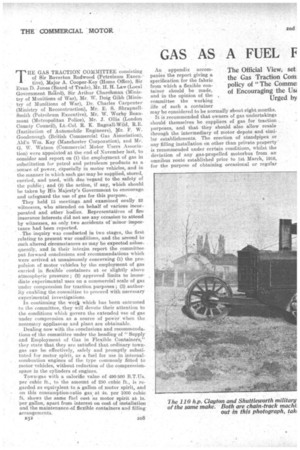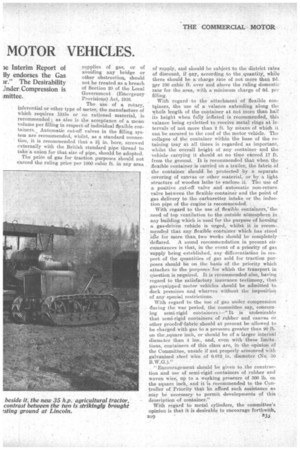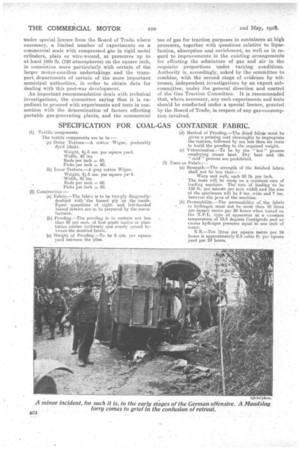GAS AS A FUEL F MOTOR VEHICLES.
Page 10

Page 11

Page 12

If you've noticed an error in this article please click here to report it so we can fix it.
THE GAS TRACTION COMMITTEE consisting of Sir Boverton Redwood (Petroleum Execti-• live), Major A. Cooper-Key (Home Office), Sir Evan D. Jones (Board of Trade), Mr. H. H. Law (Local Government Beard), Sir Arthur Churchman (Ministry of Munitions of War), Mr. W. Doig Gibb (Ministry of Munitions of War), Dr. Charles Carpenter (Ministry of Reconstruction), Mr. .E, S. ShrapnellSmith (Petroleum Executive), Mr. W. Worby Beaumont (Metropolitan Police), Mr. J. 01lis (London County Council), Lt.-Col. R. K. Bagnall-Wild, R.E. (Institution of Automobile Engineers), 4Ir. F. 'W. Goodenough (British Commercial Gas Association), Ald'n Wm. Kay (Manchester Corporation), and Mr. G. W. Watson (Commercial Motor Users Association) were appointed at the end of November la-st, to consider and report on (1) the employment of gas in substitution for petrol and petroleum products as a sounce, of power, especially in motor vehicles, and in the manner in which such gas may be supplied, stored, carried, and used, with due 'regard to the safety of -the public ; and (2) the action, if any, which should be taken by His Majesty's Government to encourage and safeguard the use of gas for this purpose.
They held 15 meetings_ and examined orally 22 witnesses, who attended on behalf of various incorporated and other bodies. Representatives of fire insurance interests did not see any occasion to attend by witnesses, as only two accidents of minor importance had been reported.
The inquiry was conducted in two stages, the first relating to present war conditions., and the szeond to such altered circumstances as may be expected subsequently, and in their interim report the committee put forward conclusions and recommendations which were arrived at unanimously concerning (1) the propulsion of .motor vehicles by the employment of gas carried. in flexible • containers at or slightly above atmospheric pressure ; (2) approved limits to immediate experimental uses on a commercial scale of gas under compression for traction purposes; (3) authority enabling the committee to proceed with necessary experimental investigations.
In continuing the wor,ji which has been entrusted to the committee, they will devote their attention to the conditions which govern the extended use of gas under eorapression as a source of power when the necessary appliances and plant are obtainable.
Dealing now with the conclusions and recommendations of the committee under the heading of "Supply and Employment of Gas in Flexible Containeis," -11-1ey state that they are satisfied that ordinary towngas can be effectively, safely and promptly substituted for motor spirit, as a fuel for use in internalcombustion engines of the type commonly fitted to motor vehicles, without reduction of the compressionspace in the cylinders of engines.
Townzgas with a calorific value of 490-500 B.T.ITs. per cubic ft., to the amount of 250 cubic ft., is regarded as equivalent to a gallon of motor spirit, and on this consumption-ratio gas. at 4s. per 1000 cubic ft. shows the same fael cost as motor spirit at is. 'per gallon, apart from interest on cost of installation and the maintenance.of flexible containers and filling arrangements. An append] x a.ccornpanics the report giving a specification for the fabric from which a flexible container should be made, and in the opinion of the committee the working iife of such a container may be considered to be normally about eight months. It is recommended that owners of gas undertakings should themselves be suppliers of gas for traction purposes, and that they should also allow resale through the intermediary of motor depots and similar establishments. The erection of standpipe's or any filling installation on other than private property' is recommended under certain conditions, whilst the deviation of any gas-propelled motorbus from an omnibus route established prior to 1st March, 1916, for the purpose of obtaining occasional or regular
The Official View, set the Gas Traction Corn policy of "The Cornmei of Encouraging the Us(
supplies of gas, or of avoiding any bridge or other obstruction, should not be treated as a breach of Section 20 of the Local Government (Emergency Provisions) Act, 1916.
The use of a rotary, inferential or other type of meter, the manufacture of which requires little or no rationed material, is. recommended; as also is the acceptance of a mean volume per filling in respect of individual flexible containers. Automatic cut-off valves in the filling. system are recommended, whilst, as a standard connection, it is recommended that a a in. bore, screwed externally with the British standard pipe thread to take -a union for that size of pipe, should be adopted.
The price of gas for traction, purposes should not exceed the ruling price per 1000 cubic ft. in any area of supply, and should be 'subject to the district rates of discount, if any, according to the. quantity, while there should be a charge rate of not more than 2d. ger 100 cubic ft. over and above the ruling domestic rate for the area, with a minimum charge of Gcl. per filling.
With regardto the attachment of flexible containers, the use of a valance extending along the whole length of the container at not more than half its height when fully inflated is recommended, this valance being eyelettecl to receive metal rings at intervals of not more than .2 ft. by means of. which it can be secured to the roof of the motor vehicle: The collapse of the container within the base of the retaining tray at all times is regarded as important, whilst the overall height of any container and the 'vehicle. carrying it should at no time eiceed 17 ft. from the ground. It is recommended that when the ...flexible container is carried on a trailer, the fabric of the container should be protected by a separate covering of canvas or other -material, or by a light structure of wooden laths to enclose it. The use of a positive cut-off valve and automatic non-return valve between the flexible 'container and the point of gas delivery to the carburetter intake or the induction pipe of the engine" is' recommended.
With regard to the use Of flexible containers,' the need of top ventilation to the outside atmosphere in any building which is used for the purpose of housing a gas-driven vehicle is -urged, whilst it is recom-. mended that any flexible container which has stood idle for more than, two weeks should be completely -deflated. A sound recommendation in present circumstances is that, in the event of a priority of gas .supply being established, any differentiation in. respet of the quantities of gas sold for traction purposes should be on the basis of the priority which attaches to the purposes for whioh the transport in question is required. It is recommended also, having regard to the satisfactory insurance testimony, that gas-equipped motor vehicles should be admitted to dock premises and wharves without the imposition
of any special restrictions. •
With regard to the use of gas under compression during the war period, the committee say, concerning semi-rigid containers :—" It is undesirable that semi-rigid containers of rubber and canvas or other proofedlabrieshould at present be 'allowed -to be chai*d with gas to a pressure greater than 90 lb. on the .square inch, or should be of a larger internal diameter than 4 ins., and, even with "these limitations, 'containers. Of this class are, in the opinion of the Committee, unsafe if not properly armoured with galvanised steel wire of 0.012 in. diameter (No. 30 B.W.G.)."
"Encouragement should be given to the construction and use of semi-rigid containers of. rubber and woven wire, up to a working pressure of 300 lb. on. the square inch, and it is recommended to the Controller of Priority that he affoed such assistance 'as may be necessary to permit developments of this
description of container." • With regard to metal cylinders, the committee's opinion is that it is desirable to encourage forthwith, .
209 • B33
under special licence from the Board of Trade where necessary, a limited number of experiments on a commercial scale with compressed gas in rigid metal cylinders, plain or wire-wound, at pressures up to at least 1.800 lb. (120 atmospheres) on the square inch, in connection more particularly with certain of the larger motor-omnibus undertakings and the transport departments of certain of the more important municipal authorities, in order to obtain data for dealing with this post-war development.
An important recommendation deals with technical investigations, the committee saying that it is expedient to proceed with experiments and tests in connection with the determination 'of factors affecting portable gas-generating plants, and the commercial
use of gas for traction purposes in containers at high pressures, together with questions relative to liquefaction, absorption and enrichment, as well as in regard to improvements in the existing arrangements for effecting the admixture of gas and air in the requisite proportions under varying conditions. Authority is, accordingly, asked by the committee to combine, with the second stage of evidence by witnesses, independent investigations by an expert subcommittee, under the general direction and control of the Gas Traction Committee. It is recommended that, where necessary, any such experiments and tests should be conducted under a special licence, granted by the Board of Trade, in respect of any gas-consumption involved.






















